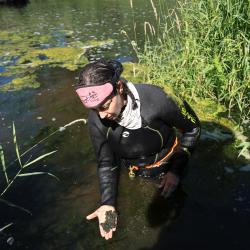
Sascha Hallett
Sascha Hallett
Biography
Background
I undertook a Ph.D. at the University of Queensland, Brisbane, Australia, with Professor Bob Lester and Peter O'Donoghue on "Myxozoan Parasites of Oligochaetes and Fish". I was then awarded an Alexander von Humboldt Research Fellowship to study with Professor Mansour El-Matbouli at the University of Munich, Germany for two years still focusing on myxozoan parasites. Then I procured a post-doc position with Dr Jerri Bartholomew at Oregon State University, USA, in 2003 where I have been studying myxozoan parasites of the Pacific Northwest.
Courses
- Designed and instruct: MB 480 General Parasitology Ecampus
- Contributed lectures and labs: MB 491/591 Diseases of Fish in Aquaculture and Conservation Biology, and the Salmonid Workshop
Research
I find parasites fascinating organisms and have always been drawn to the aquatic environment. Thus, I am interested in parasites of marine and freshwater fish. Most of my research has focused on one phylum - the Myxozoa and I've never dissected a fish without encountering at least one of these microscopic, spore-forming, endoparasitic metazoans. Over 2000 are found in fish world-wide and most do not harm their host, but there are several that cause serious diseases (Ceratonova shasta, Parvicapsula minibicornis, Myxobolus cerebralis) in the Pacific Northwest of North America. My current research focuses on answering questions about these parasites so that we can make informed management decisions and reduce their impact on native fishes.
Specific Interests
- Discovery and description of novel species
- Taxonomy (morphological & molecular characterization)
- Nomenclature (accurate and unambiguous identification and naming of organisms)
- Discovering life cycles
- Molecular diagnoses and development of detection assays
- Enumeration of waterborne stages
- Ecosystem impacts
- Adaptive management and disease mitigation
Current projects
Klamath River Fish Health Studies: Salmon Disease Monitoring and Research
Funded by: U.S. Bureau of Reclamation; began 2019
Personnel: Jerri Bartholomew, Julie Alexander, Rich Holt, Ryan Craig, Stephen Atkinson, Kristin Kasschau, Denise de Silva, Ruth Milston-Clements, Auden Heitzler, Elliott Cameron (MS student)Hayden Krause (MS student)
We are involved in a long term monitoring and research project that includes sentinel fish studies, annelid sampling and water sampling to describe the distribution and abundance of harmful fish pathogens in the Klamath River (OR/CA). The data we collect informs model development and real time adaptive management to mitigate fish disease in this system. This collaborative effort involves colleagues from the Karuk, Yurok and Hoopa tribes and the USFWS Arcata office.
For more information about this project and our latest data, please visit our monitoring page.
These efforts have contributed to a collaborative review published in Frontiers: Deconstructing dams and disease: predictions for salmon disease risk following Klamath River dam removals
Salmon disease risk in the Klamath River’s hydroelectric project reach, prior to dam removal
Funded by: PacifiCorp; Began: 2021
Personnel: Julie Alexander, Ryan Craig, Stephen Atkinson, Elliott Cameron (MS student), Hayden Krause (MS student), ODFW, CDFW
The freshwater parasites, Ceratonova shasta and Parvicapsula minibicornis can cause disease in salmonids downstream of the dams in the Klamath River. Less is known about these parasites in the hydroelectric reach, the region between the dams, and raises the question of how the project reach and proximal river sections will change following dam removal in 2024. This collaborative project with ODFW and CDFW fish biologists will quantify waterborne parasite densities to document parasite spatial and temporal distribution and to conduct invertebrate host (annelid) studies to document host density and infection in the hydroelectric project reaches.
Detecting and Genetically Verifying Key Aquaculture Viruses Autonomously and Continuously
Funded by: USDA NIFA-SBIR; Began: 2022
Personnel: Jerri Bartholomew, Melissa White (ODFW), Nilanjana Das (MS student)
Viral pathogens can cause disease in wild and cultured fish populations. We are partnering with ODFW fish health specialists and Nucleic Sensing Systems (NS2) to advance the use of a continuous, onsite eDNA detector to include viral RNA, such as IHNV, to provide actionable information in real-time without human intervention.
Laboratory validation of real-time polymerase chain reaction (qPCR) analysis for Myxobolus cerebralis
Funded by: Great Lakes Fishery Commission; Began: 2022
Personnel: Stephen Atkinson
We are working with members of the American Fisheries Society-Fish Health Section, led by Wade Cavendar (Utah) to test the sensitivity and specificity of published qPCR assays to recommend an approach for researchers and fish health professionals.
Emergence of Proliferative Kidney Disease in Salmonids at Oregon Hatcheries
Funded by: Oregon State University Ag Experiment Station Animal Health and Disease Research Program
Personnel: Stephen Atkinson, Nilanjana Das (MS student), Sarah Bjork (ODFW), Aimee Reed (ODFW)
Monitoring and Modeling Pathogen Exposure in Salmon Migrating to the Delta
Funded by: CDFW Proposition 1 Delta Water Quality & Ecosystem Restoration Grant program, Delta Stewardship Council, and U.S. Bureau of Reclamation; began 2019
Personnel: Stephen Atkinson, Kristin Kasschau, Denise Silva
This collaborative effort led by Miles Daniels (NOAA & UCSC), and involving UC Davis aims to characterize the distribution and abundance of fish pathogens in Central Valley Chinook salmon during their outmigration through the Sacramento and Feather Rivers. The approach includes sentinel fish exposures, river water collection and molecular analyses.
Education
Ph.D. at the University of Queensland, Brisbane, Australia
Publications
Book chapters
Bartholomew, J.L., Atkinson, S.D., Hallett, S.L., and Alexander, J.D. 2021. Myxobolus cerebralis; in Fish Parasites: A handbook of protocols for their isolation, culture, and transmission Eds Sitjà-Bobadilla, A., Bron, J.E., Wiegertjes, G., Piazzon, M.C.; 5M Books, Sheffield, UK.- Bartholomew, J.L., Atkinson, S.D., Hallett, S.L., and Alexander, J.D. 2021. Ceratonova shasta; in Fish Parasites: A handbook of protocols for their isolation, culture and transmission Eds Sitjà-Bobadilla, A., Bron, J.E., Wiegertjes, G., Piazzon, M.C.; 5M Books, Sheffield, UK.
- Hallett, S.L., Hartigan, A., and Atkinson, S.D. 2015. Myxozoans on the move: dispersal modes, exotic species and emerging diseases. In: Myxozoan Evolution, Ecology and Development Okamura B, Gruhl A, Bartholomew JL (eds). Springer.
- Hallett, S.L., Atkinson, S.D., Bartholomew, J.L. and Székely, C.S. 2015. Myxozoans exploiting homeotherms. In: Myxozoan Evolution, Ecology and Development Okamura B, Gruhl A, Bartholomew JL (eds). Springer.
- Fontes, I., Hallett, S.L., and Mo, T.A. 2015. Comparative epidemiology of myxozoan diseases. In: Myxozoan Evolution, Ecology and Development Okamura B, Gruhl A, Bartholomew JL (eds). Springer.
- Alexander, J.D., Kerans, B.L., El-Matbouli, M., Hallett, S.L., and Stevens, S.L. 2015. Annelid-myxosporean interactions. In: Myxozoan evolution, Ecology and Development Okamura B, Gruhl A, Bartholomew JL (eds). Springer.
- Bartholomew J.L. and Hallett S.L. 2013. Myxobolus cerebralis. In: Invasive Species Compendium. CABI, Oxfordshire, UK. http://www.cabi.org/isc/datasheet/73782
- Hallett S.L. and Bartholomew J.L. 2012. Chapter 8: Myxobolus cerebralis and Ceratomyxa shasta. In: Fish Parasites: Pathobiology and Protection. Editors: Woo P.T.K. & Buchmann K. CABI, Oxfordshire, UK.
Journal articles (past 5 years)
- Bartholomew J.L., Atkinson S.D., Alexander J.D., Hallett S.L., Alama-Bejamo G. (2022) Ceratonova shasta – a cnidarian parasite of annelids and salmonids. Parasitology 149: 1862-1875 https://doi.org/10.1017/S0031182022001275
- Robinson H.E., Alexander J.D., Bartholomew, J.L., Hallett S.L., Hetrick N., Perry R., Som N.A. (2022) Using a mechanistic framework to model the density of an aquatic parasite Ceratonova shasta. PeerJ 10:e13183 https://doi.org/10.7717/peerj.13183
- Nguyen CN, Nguyen HV, Pham DN, Yurakhno V, Yoshinaga T, Shirakashi S, Hallett SL, Whipps CM (2022) Morphological and molecular characterization of Ceratomyxa binhthuanensis n. sp. (Myxosporea: Ceratomyxidae) from the gall bladder of blacktip grouper Epinephelus fasciatus (Perciformes: Serranidae) in the East Sea of Vietnam. Parasitology Research 121: 613–621.
- Borzák, R., Borkhanuddin, M.H., Cech, G., Molnár, K., Hallett, S.L., and Székely, C. 2021. New data on Thelohanellus nikolskii Achmerov, 1955 (Myxosporea, Myxobolidae) a parasite of the common carp (Cyprinus carpio, L.): the actinospor
- Lehman, B.M., Johnson, R.C., Adkison, M., Burgess, O.T., Connon, R.E., Fangue, N.A., Foott, J.S., Hallett, S.L., Martinez–López, B., Miller, K.M., Purcell, M.K., Som, N.A., Valdes–Donoso, P., and Collins A.L. 2020. Disease in Central Valley Salmon: Status and Lessons from Other Systems. San Francisco Estuary and Watershed Sci. 18 (3) Article 2: 1-31. https://doi.org/10.15447//sfews.2020v18iss3art2.
- Robinson, H.E., Alexander, J.D., Hallett, S.L., and Som, N.A. 2020. Management Brief: Prevalence of infection in hatchery‐origin Chinook Salmon correlates with abundance of Ceratonova shasta spores: implications for management and disease risk. North American J. of Fish. Mgmt. 40: 959-972.
- Richey, C.A., Kenelty, K.V., Van Stone Hopkins, K. Stevens, B.N., Martinez-Lopez, B., Barnum, S.M., Stevens, B.N., Hallett, S.L., Atkinson, S.D., Bartholomew, J.L., and Soto, E. 2020. Validation of environmental DNA sampling for determination of Ceratonova shasta (Cnidaria: Myxozoa) distribution in Plumas National Forest, CA. Parasit. Res. https://doi.org/10.1007/s00436-019-06509-1.
- Howell, C.K., Atkinson, S.D., Bartholomew, J.L., and Hallett, S.L. 2019. Development and application of a qPCR assay targeting Ichthyophthirius multifiliis in environmental water samples. Dis. of Aquatic Org. 134:43-55.
- Atkinson, S.D., Hallett, S.L., Diaz Morales, D., Bartholomew, J.L. and deBuron, I. 2019. First myxozoan infection (Cnidaria: Myxosporea) in a marine polychaete from North America and erection of actinospore collective group Saccimyxon. J. of Parasit. 105:252-262.
- Javaheri, A., Babbar-Sebens, M., Miller, R.N., Hallett, S.L., and Bartholomew, J.L. 2019. An adaptive ensemble Kalman filter for assimilation of multi-sensor, multi-modal water temperature observations into hydrodynamic model of shallow rivers. J. of Hydrology 572:682-691.
- Javaheri, A., Babbar-Sebens, M., Alexander, J.A., Bartholomew, J.L., and Hallett, S.L. 2018. Global sensitivity analysis of water age and temperature for informing salmonid disease management. J. of Hydrology 561:89-97.
- Atkinson, S.D., Hallett, S.L., and Bartholomew, J.L. 2018. Genotyping of individual Ceratonova shasta (Cnidaria: Myxosporea) myxospores reveals intra-parasite ITS-1 variation and invalidates the distinction of genotypes II and III. Parasit. 145:1588-1593.
- Richey C.A., Kenelty K.V., Van Stone Hopkins K., Stevens B.N., Martínez-López B., Barnum S.M., Hallett S.L., Atkinson S.D., Bartholomew J.L., Soto E. (2018) Distribution and prevalence of Myxobolus cerebralis in postfire areas of Plumas National Forest: utility of environmental DNA sampling. Journal of Aquatic Animal Health 30: 130-143. https://doi.org/10.1002/aah.10014.
Read more on Sascha's Google Scholar
Presentations
Publicity
July 13, 2021 - Phone Interview with Sophia Prince: Jefferson Public Radio (Southern Oregon University, Ashland, OR). Resulted in “Poor Klamath River Water Conditions, Deadly Parasite, Prompts Fish Hatchery to Delay Salmon Release” // Jefferson Public Radio | By Sophia Prince //Published July 14, 2021 at 7:16 PM PDT https://www.ijpr.org/environment-energy-and-transportation/2021-07-14/poor-klamath-river-water-conditions-deadly-parasite-prompts-fish-hatchery-to-delay-salmon-release- July 14, 2021 “California hatchery won’t release salmon into parasite-ridden Klamath River”. The Oregonian: Pacific Northwest. https://www.oregonlive.com/pacific-northwest-news/2021/07/oregon-hatchery-wont-release-salmon-into-parasite-ridden-klamath-river.html
- July 10, 2021 “Iron Gate Hatchery won't release fish into Klamath River” by Alex Schwartz Herald & News Staff Reporter / Report for America. https://www.heraldandnews.com/news/local_news/iron-gate-hatchery-wont-release-fish-into-klamath-river/article_3459f903-1d0b-5679-9b79-b6bb622993e9.html
- May 22, 2021 “Dead in the water: Serious fish kill consumes the Klamath River” by Alex Schwartz Herald & News Staff Reporter / Report for America. https://www.heraldandnews.com/news/local_news/dead-in-the-water-serious-fish-kill-consumes-the-klamath-river/article_286cc625-6d3b-5dec-803d-efe6438acc4c.html
- May 14, 2019 “After Klamath River flushes, C. shasta spores spike, surprising scientists” by Gerry O’Brien, Herald and News Editor. https://www.heraldandnews.com/news/local_news/after-klamath-river-flushes-c-shasta-spores-spike-surprising-scientists/article_81251441-f966-5e11-8384-676f19194f45.html
- July 7, 2011 “Saving Salmon” by Sara Hottman Herald and News https://www.heraldandnews.com/news/article_11b56d9a-a860-11e0-aa4b-001cc4c002e0.html
- March 24, 2010 “Klamath River fish diseases spreading” by John Driscoll and THE TIMES-STANDARD https://www.times-standard.com/2010/03/24/klamath-river-fish-diseases-spreading/
